This is the remarkable story of a bunch of army reservists who set up a volunteer rifle corps in Strathbungo, and within a few years had won both Britain’s greatest trophy for marksmanship, The Queen’s Prize at Bisley, and Scotland’s greatest football trophy, the FA Cup. Twice. Oh, and the football league. Sharpshooters indeed!
The 3rd Lanarkshire Rifle Volunteers
In 1859-60, fear of war with France led to the development of the Rifle Volunteer movement, the forerunners of today’s Territorial Army. A group of veteran volunteers (of the Glasgow Light Horse of 1796, volunteers of 1803 and Sharpshooters of 1819) formed the 78th Corps, and styled themselves the “Old Guard of Glasgow”. Their most senior member, Robert Reid, was 88 years old! One of the first corps to form, they served mainly to show the youngsters of the day how it should be done, although they appear never to have actually drilled or appeared in uniform.
A number of other Volunteer Corps were then raised locally, including the 3rd, 10th & 14th Corps, at Messrs Cogan’s Spinning Factory (22nd Corps), a number of temperance societies (54th & 82nd Corps), Messrs Inglis & Wakefield’s at Busby (87th Corps), and Etna Foundry (8th Company), manufacturers of fine cast iron grave memorials, on Lilybank Road (later the gasworks off Maxwell Road).
The first public appearance of any Scottish volunteers was on 14 October 1859, when volunteers from the south Glasgow corps collectively provided Queen Victoria with a guard of honour at the opening of Glasgow’s new water works at Loch Katrine. On 7th August 1860 they took part in a Royal Review in Edinburgh, again before Queen Victoria, 730 men strong. In total, 21,514 Scottish volunteers paraded in front of 200,000 spectators on Arthur’s Seat. Illustrations from the time, including Samuel Bough’s painting in the National Gallery , and an engraving from the Illustrated London News, show how seriously the volunteer movement was being taken.

Samuel Bough, Royal Volunteer Review, 7 August 1860 – click for original
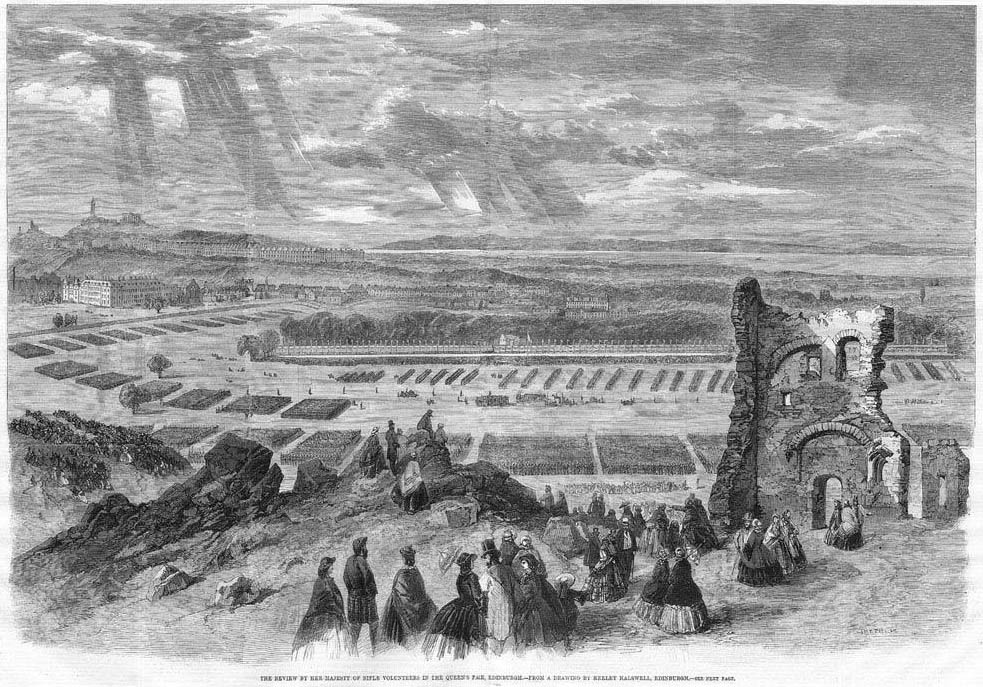
1860 Royal Review, Edinburgh – Illustrated London News
The following day, 8th August, the south Glasgow corps were incorporated together into the 3rd Lanarkshire Rifle Volunteers (3rd LRV), and the corps was based in the southside of Glasgow, around the village of Strathbungo . They held a Grand Rifle Competition in South-Side Park (now Queens Park) on 20th October that year, against the West Yorkshire Rifles.
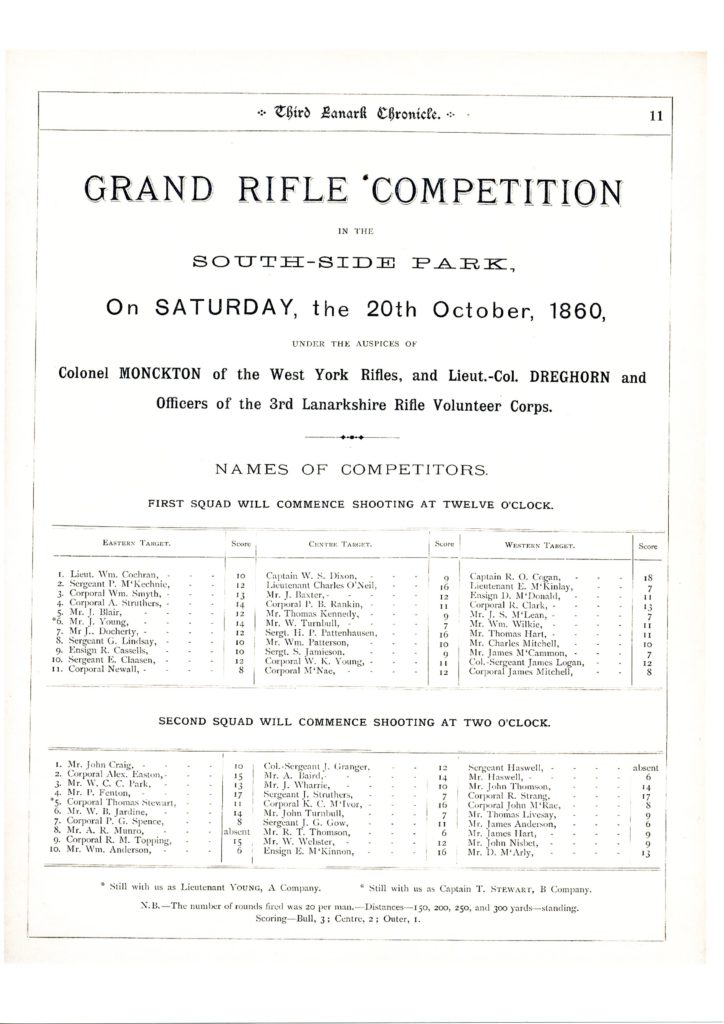

3rd LRV badge
In 1860, Strathbungo was a weavers’ village, centred on Pollokshaws Road and Allison Street, and surrounded by fields and nurseries, such as the nursery at Coplawhill, and with Little Govan Colliery to the east. The volunteers used the ground north of the village as their base.
The map below shows the area north of Strathbungo village circa 1858, just before major development began. The parade ground (and first football pitch) would have been roughly in the centre of the map, east of the main road and south of the nursery at Coplawhill.

1858 OS Map of Strathbungo (Composite).
The Glasgow Herald of 27 May 1862 described the Corps’ first camp, when 692 men were under canvas for a week. The account includes the tale of a drunken bet to steal the regiment’s colours, which was foiled by the guard.

Glasgow Herald – click for pdf
This photograph is from another such camp, taken in Queens Park, dated 1873 .
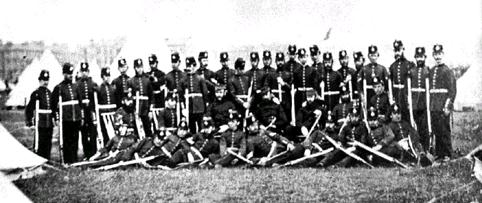
3rd LRV Camp, Queens Park, 1873
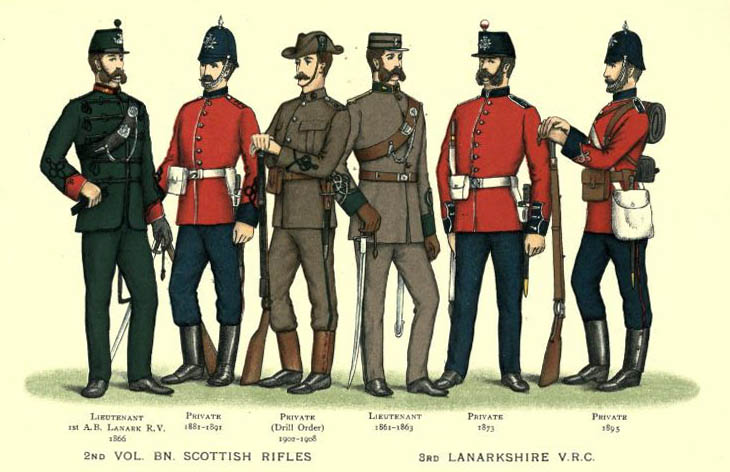
3rd LRV uniforms (on the right)
The Queen’s Prize
The 3rd LRV shared a rifle range with the 1st LRV at Darnley. The thirds were known as excellent shots – two members won the highest accolade in marksmanship, the Queen’s Prize at the National Rifle Association meeting at Bisley; Private Malcolm Stark Rennie in 1894 and Lieutenant David Yates in 1898. Private Boyd also tied for the title in 1895 .
While the prize may not be known to many, it is the ultimate sporting accolade for a marksman. Despite almost not making it to the start, Private Rennie won it for the Third Lanark, and the story featured in all the papers . He returned to Glasgow to a hero’s welcome, being carried in a chair from Central Station to the Drill Hall through a thronging crowd. What is more, Third Lanark won second and fourth place, and placed nine men in the Queen’s Hundred, a massive achievement .

Private Rennie arrives in Glasgow – available from AllPosters
Rennie was even awarded the much cherished Sloper’s Award of Merit. Ally Sloper was the world’s first fictional comicstrip (anti)hero, and a huge phenomenon in late 19th Century Britain, and his joke awards were given out to those who made it big in the news.
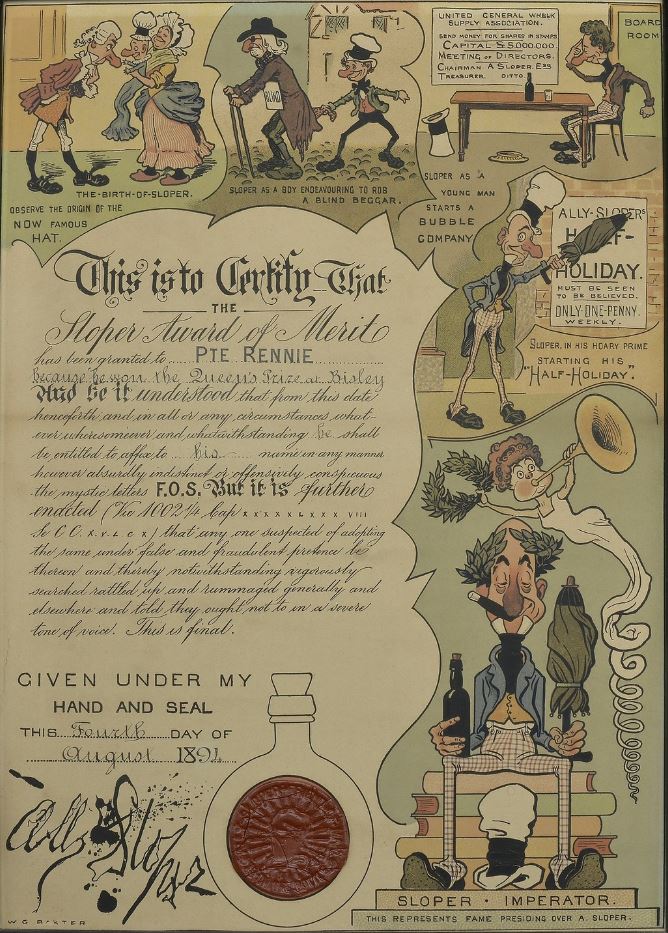
Sloper Award of Merit to Pte Rennie
All the more remarkable then, when Lt Yates won it again four years later. He too returned to Glasgow to a hero’s welcome.
In 1881 the four Lanarkshire volunteer regiments were attached to the newly formed Cameronians (Scottish Rifles) regiment as part of army reforms, and went on to fight both in the Boer War, and at Gallipoli in the Great War, where they suffered massive casualties.
Following publication of this story, I was contacted by Lucy O’Reilly (see comments), who had found Private Rennie’s Queen’s Prize certificate in a second hand photo album. She kindly sent a copy.
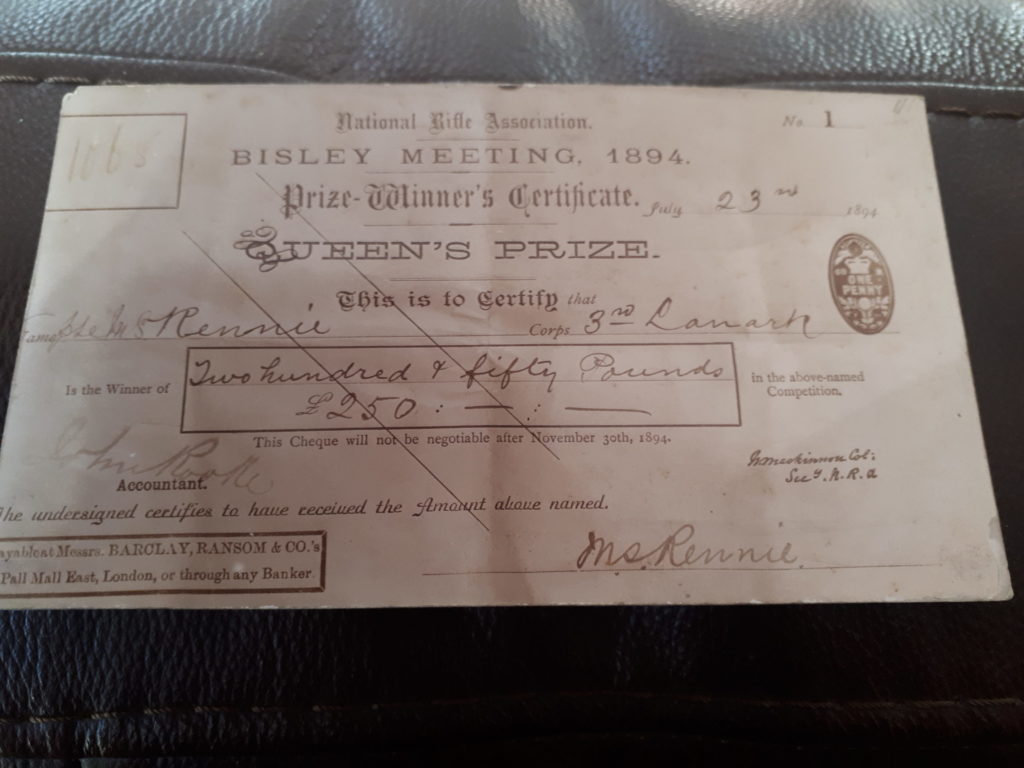
Malcolm Rennie’s Queen’s Prize Certificate 1894
The Drill Hall
John Bennie Wilson was a member of the regiment who gradually rose up the ranks. He was also an architect, and designed a new Headquarters and Drill Hall for the volunteers in Coplaw Street. The drill hall, built 1884-5, and extended by the same architect in 1904, is still there, converted in 2001 to private flats . During the conversion some of the original 1884 building was taken down, and a time capsule from 1884 was discovered. Wilson also designed the extension to 1 Moray Place, and lived himself at one point on Pollokshaws Road, at 16 Regent Park Terrace (now 2 Vennard Gardens). He rose to become honorary colonel of the corps in 1905.

Regimental Drill Hall, Coplaw Street

Drill Hall Crest: 7th Battalion Cameronians Scottish Rifles, “Defence not Defiance”
The corps were only renamed the 7th Battalion of the Cameronians (Scottish Rifles) in 1908, so the crest at the Drill Hall must have been a later alteration or addition.
A Football Club is Born
The first ever international football match, Scotland vs England, was played at the West of Scotland Cricket Ground in Partick on St Andrew’s Day, 1872. The match was organised by Queen’s Park, FC who provided the entire team, although several of the players, such as Billy Dickson, Joseph Taylor and Pte William McKinnon, were also members of the 3rd LRV.
Inspired by the match, the regiment decided to set up its own football team twelve days later. The Third Lanark Rifle Volunteers Football Club was born on 12th December 1872, at a meeting in the Regimental Orderly Room in East Howard Street, in the centre of Glasgow, with the support of Lieutenant Colonel Humphry Ewing Crum-Ewing, the majority of officers and 25 men .
Captain John Inglis was elected president, and much of the initial organisation was down to John Wallace, the goalkeeper, and the aforementioned Colonel John Wilson, their striker, who was later to score Third Lanark’s first ever league goal. Practice was undertaken at the regimental parade ground just north of Strathbungo village.
In 1875 the club moved to Old Cathkin Park in Govanhill, a site provided by Dixon’s Blazes, the famous iron foundry. The site corresponds to the junction of of Cathcart Road and Dixon Road. A grandstand was built, and a Scotland-England international was played there in 1884. Scotland won 1-0, watched by a crowd of 10,000 .

1893/4 OS Map showing the Drill Hall upper left, and the first Cathkin Park Ground, bottom right
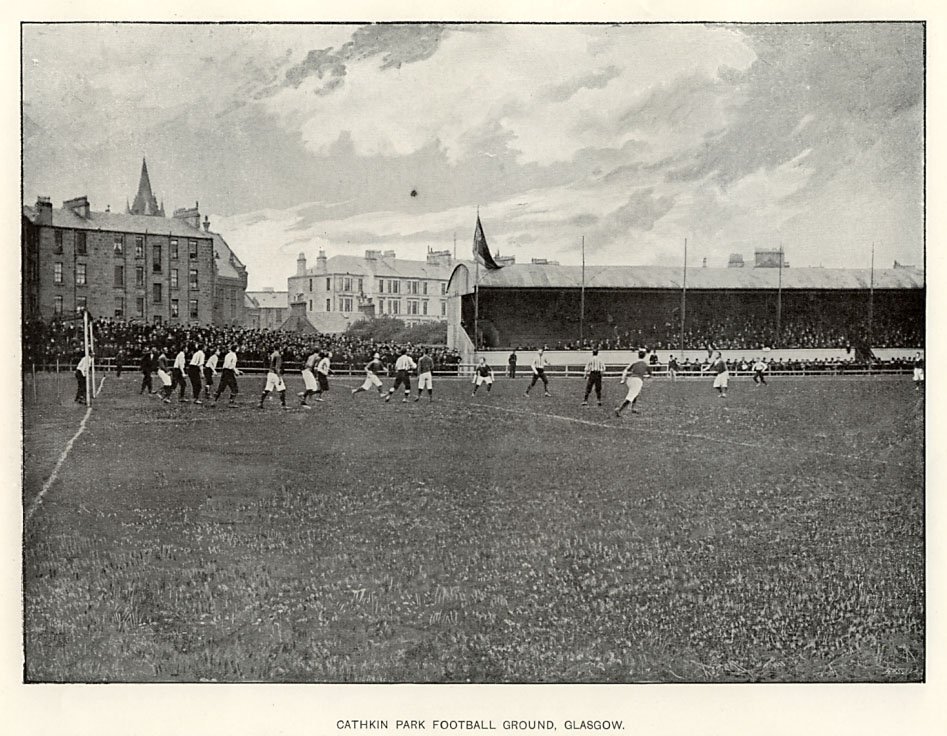
First Cathkin Park off Cathcart Road, with Dixon Hall visible behind the tenements. Glasgow Charity Cup final, May 25th 1895 when Celtic defeated Rangers 4-0. Source: Canmore
Strathbungo 2 Old Firm 0
As a football team, the regiment fared surprisingly well. They won the FA Cup twice, scoring notable victories over both Celtic (1889) and Rangers (1905), as well as winning the football league in 1904.

The Scottish FA Cup, won twice by Third Lanark
The Thirds also have a claim to one of the world’s first black footballers, Robert Walker, and the first to play in a major competition, the Scottish Cup Final of 1876 .
If football wasn’t spectacle enough, the regiment’s parade ground also hosted Buffalo Bill’s Wild West touring show for 6 days in 1904 .

Buffalo Bill’s Wild West Poster
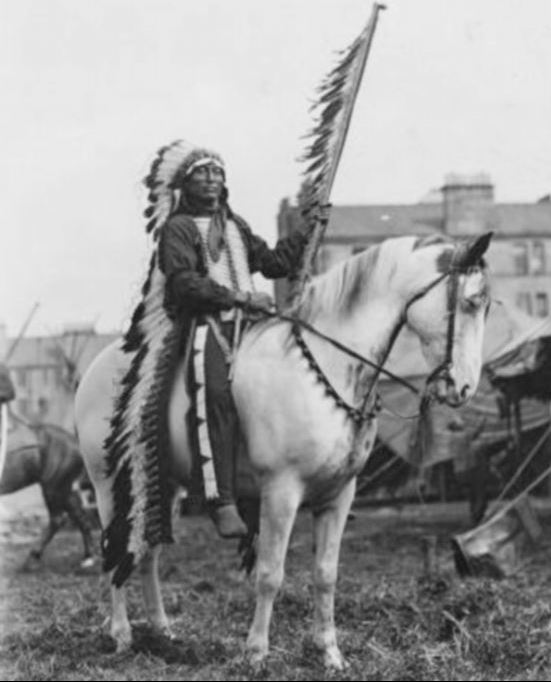
“Red Indian” in Glasgow 1904
The football club finally severed its ties to the regiment in 1903, when it became Third Lanark Athletic Club. That year Queen’s Park moved to their third (and current) Hampden Park. Third Lanark bought second Hampden Park, and renamed it New Cathkin Park. There they stayed, until their demise under dubious financial circumstances in 1967.
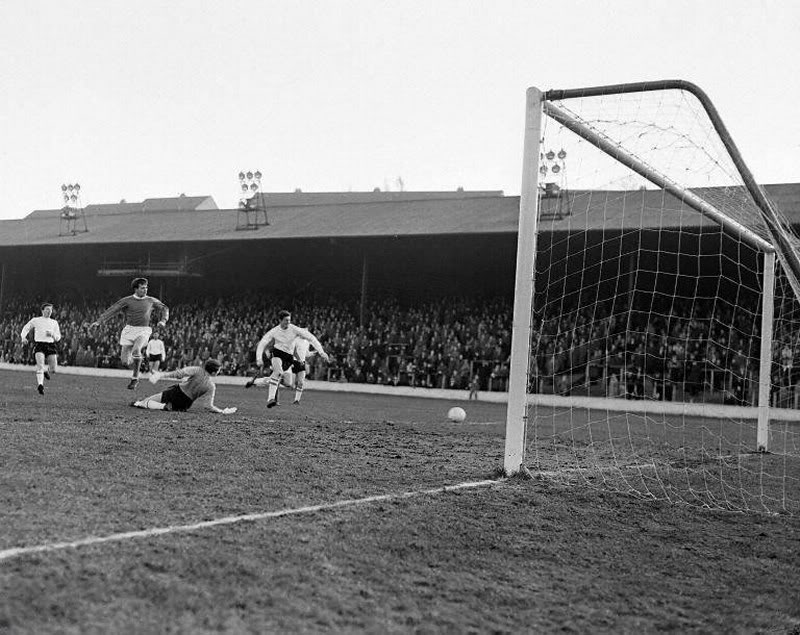
Thirds v Aberdeen 2 Feb 1960
Cathkin Park is now owned by the Council. The football pitch is still there, a most curious sight, where trees grow out of the terraces that once held 45,000 people, the day the Thirds played Rangers in 1954.
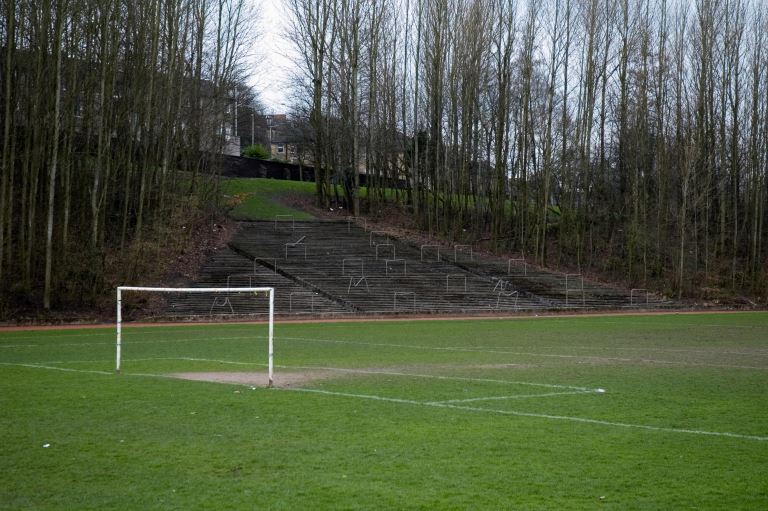
Cathkin Park
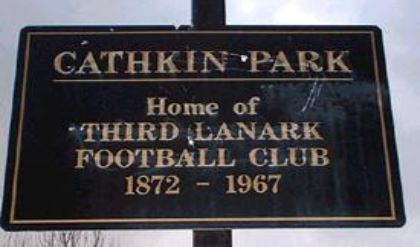
Cathkin Park
So there you have it, Strathbungo – one of the great pioneers of the beautiful game. Sort of.
References
{3557955:EG4BT54G};{3557955:HKCI8WC7},{3557955:DG44AN7B},{3557955:NAMM22AR};{3557955:DK2RDY8R};{3557955:93FHG326};{3557955:MAUCTX7Y};{3557955:W7HJTVJK};{3557955:5G5BZDRD},{3557955:SNJ227J2};{3557955:2QENFBQT};{3557955:USDJJGJJ};{3557955:9MJGJCZ6};{3557955:UHBHJ4Q4};{3557955:UPPJB3WI}
vancouver
asc
0
72
%7B%22status%22%3A%22success%22%2C%22updateneeded%22%3Afalse%2C%22instance%22%3A%22zotpress-6603bad1fd6fb0e7a9d88aa5d5998a0b%22%2C%22meta%22%3A%7B%22request_last%22%3A0%2C%22request_next%22%3A0%2C%22used_cache%22%3Atrue%7D%2C%22data%22%3A%5B%7B%22key%22%3A%22MAUCTX7Y%22%2C%22library%22%3A%7B%22id%22%3A3557955%7D%2C%22meta%22%3A%7B%22creatorSummary%22%3A%22McDowall%2C%20John%20K%22%2C%22parsedDate%22%3A%221899%22%2C%22numChildren%22%3A0%7D%2C%22bib%22%3A%22%3Cdiv%20class%3D%5C%22csl-bib-body%5C%22%20style%3D%5C%22line-height%3A%201.35%3B%20%5C%22%3E%5Cn%20%20%3Cdiv%20class%3D%5C%22csl-entry%5C%22%20style%3D%5C%22clear%3A%20left%3B%20%5C%22%3E%5Cn%20%20%20%20%3Cdiv%20class%3D%5C%22csl-left-margin%5C%22%20style%3D%5C%22float%3A%20left%3B%20padding-right%3A%200.5em%3B%20text-align%3A%20right%3B%20width%3A%201em%3B%5C%22%3E1.%3C%5C%2Fdiv%3E%3Cdiv%20class%3D%5C%22csl-right-inline%5C%22%20style%3D%5C%22margin%3A%200%20.4em%200%201.5em%3B%5C%22%3EMcDowall%2C%20John%20K.%20People%26%23x2019%3Bs%20history%20of%20Glasgow%26%23x202F%3B%3A%20an%20encyclopedic%20record%20of%20the%20city%20from%20the%20prehistoric%20to%20the%20present%20day%20%5BInternet%5D.%20Hay%20Nisbet%20%26amp%3B%20Co%3B%201899.%20Available%20from%3A%20%3Ca%20href%3D%27https%3A%5C%2F%5C%2Fia802902.us.archive.org%5C%2F8%5C%2Fitems%5C%2Fpeopleshistoryof02mdow%5C%2Fpeopleshistoryof02mdow.pdf%27%3Ehttps%3A%5C%2F%5C%2Fia802902.us.archive.org%5C%2F8%5C%2Fitems%5C%2Fpeopleshistoryof02mdow%5C%2Fpeopleshistoryof02mdow.pdf%3C%5C%2Fa%3E%3C%5C%2Fdiv%3E%5Cn%20%20%3C%5C%2Fdiv%3E%5Cn%3C%5C%2Fdiv%3E%22%2C%22data%22%3A%7B%22itemType%22%3A%22document%22%2C%22title%22%3A%22People%27s%20history%20of%20Glasgow%20%3A%20an%20encyclopedic%20record%20of%20the%20city%20from%20the%20prehistoric%20to%20the%20present%20day%22%2C%22creators%22%3A%5B%7B%22creatorType%22%3A%22author%22%2C%22firstName%22%3A%22%22%2C%22lastName%22%3A%22McDowall%2C%20John%20K%22%7D%5D%2C%22abstractNote%22%3A%22%22%2C%22date%22%3A%221899%22%2C%22language%22%3A%22%22%2C%22url%22%3A%22https%3A%5C%2F%5C%2Fia802902.us.archive.org%5C%2F8%5C%2Fitems%5C%2Fpeopleshistoryof02mdow%5C%2Fpeopleshistoryof02mdow.pdf%22%2C%22collections%22%3A%5B%22CAR6MXPM%22%5D%2C%22dateModified%22%3A%222023-10-01T19%3A25%3A24Z%22%7D%7D%2C%7B%22key%22%3A%22DK2RDY8R%22%2C%22library%22%3A%7B%22id%22%3A3557955%7D%2C%22meta%22%3A%7B%22numChildren%22%3A0%7D%2C%22bib%22%3A%22%3Cdiv%20class%3D%5C%22csl-bib-body%5C%22%20style%3D%5C%22line-height%3A%201.35%3B%20%5C%22%3E%5Cn%20%20%3Cdiv%20class%3D%5C%22csl-entry%5C%22%20style%3D%5C%22clear%3A%20left%3B%20%5C%22%3E%5Cn%20%20%20%20%3Cdiv%20class%3D%5C%22csl-left-margin%5C%22%20style%3D%5C%22float%3A%20left%3B%20padding-right%3A%200.5em%3B%20text-align%3A%20right%3B%20width%3A%201em%3B%5C%22%3E1.%3C%5C%2Fdiv%3E%3Cdiv%20class%3D%5C%22csl-right-inline%5C%22%20style%3D%5C%22margin%3A%200%20.4em%200%201.5em%3B%5C%22%3EThird%20Lanark%20Chronicle.%3C%5C%2Fdiv%3E%5Cn%20%20%20%3C%5C%2Fdiv%3E%5Cn%3C%5C%2Fdiv%3E%22%2C%22data%22%3A%7B%22itemType%22%3A%22manuscript%22%2C%22title%22%3A%22Third%20Lanark%20Chronicle%22%2C%22creators%22%3A%5B%5D%2C%22abstractNote%22%3A%22%22%2C%22manuscriptType%22%3A%22%22%2C%22date%22%3A%22%22%2C%22language%22%3A%22%22%2C%22url%22%3A%22%22%2C%22collections%22%3A%5B%22CAR6MXPM%22%5D%2C%22dateModified%22%3A%222019-06-29T19%3A49%3A15Z%22%7D%7D%2C%7B%22key%22%3A%225G5BZDRD%22%2C%22library%22%3A%7B%22id%22%3A3557955%7D%2C%22meta%22%3A%7B%22parsedDate%22%3A%221894-07-23%22%2C%22numChildren%22%3A1%7D%2C%22bib%22%3A%22%3Cdiv%20class%3D%5C%22csl-bib-body%5C%22%20style%3D%5C%22line-height%3A%201.35%3B%20%5C%22%3E%5Cn%20%20%3Cdiv%20class%3D%5C%22csl-entry%5C%22%20style%3D%5C%22clear%3A%20left%3B%20%5C%22%3E%5Cn%20%20%20%20%3Cdiv%20class%3D%5C%22csl-left-margin%5C%22%20style%3D%5C%22float%3A%20left%3B%20padding-right%3A%200.5em%3B%20text-align%3A%20right%3B%20width%3A%201em%3B%5C%22%3E1.%3C%5C%2Fdiv%3E%3Cdiv%20class%3D%5C%22csl-right-inline%5C%22%20style%3D%5C%22margin%3A%200%20.4em%200%201.5em%3B%5C%22%3EQueen%26%23x2019%3Bs%20Prize%20Winner.%20Cardiff%20Evening%20Express%20%5BInternet%5D.%201894%20Jul%2023%20%5Bcited%202017%20Feb%2019%5D%3B%20Available%20from%3A%20%3Ca%20href%3D%27http%3A%5C%2F%5C%2Fnewspapers.library.wales%5C%2Fview%5C%2F3246041%5C%2F3246045%5C%2F77%27%3Ehttp%3A%5C%2F%5C%2Fnewspapers.library.wales%5C%2Fview%5C%2F3246041%5C%2F3246045%5C%2F77%3C%5C%2Fa%3E%3C%5C%2Fdiv%3E%5Cn%20%20%3C%5C%2Fdiv%3E%5Cn%3C%5C%2Fdiv%3E%22%2C%22data%22%3A%7B%22itemType%22%3A%22newspaperArticle%22%2C%22title%22%3A%22Queen%27s%20Prize%20Winner.%22%2C%22creators%22%3A%5B%5D%2C%22abstractNote%22%3A%22%22%2C%22date%22%3A%2223%20July%201894%22%2C%22section%22%3A%22%22%2C%22language%22%3A%22%22%2C%22ISSN%22%3A%22%22%2C%22url%22%3A%22http%3A%5C%2F%5C%2Fnewspapers.library.wales%5C%2Fview%5C%2F3246041%5C%2F3246045%5C%2F77%22%2C%22collections%22%3A%5B%22CAR6MXPM%22%5D%2C%22dateModified%22%3A%222017-02-19T23%3A04%3A57Z%22%7D%7D%2C%7B%22key%22%3A%22SNJ227J2%22%2C%22library%22%3A%7B%22id%22%3A3557955%7D%2C%22meta%22%3A%7B%22parsedDate%22%3A%221898-07-28%22%2C%22numChildren%22%3A1%7D%2C%22bib%22%3A%22%3Cdiv%20class%3D%5C%22csl-bib-body%5C%22%20style%3D%5C%22line-height%3A%201.35%3B%20%5C%22%3E%5Cn%20%20%3Cdiv%20class%3D%5C%22csl-entry%5C%22%20style%3D%5C%22clear%3A%20left%3B%20%5C%22%3E%5Cn%20%20%20%20%3Cdiv%20class%3D%5C%22csl-left-margin%5C%22%20style%3D%5C%22float%3A%20left%3B%20padding-right%3A%200.5em%3B%20text-align%3A%20right%3B%20width%3A%201em%3B%5C%22%3E1.%3C%5C%2Fdiv%3E%3Cdiv%20class%3D%5C%22csl-right-inline%5C%22%20style%3D%5C%22margin%3A%200%20.4em%200%201.5em%3B%5C%22%3EThe%20Queen%26%23x2019%3Bs%20Prizeman.%20Enthusiastic%20Reception%20in%20Glasgow.%20Glasgow%20Herald%20%5BInternet%5D.%201898%20Jul%2028%20%5Bcited%202017%20Feb%2019%5D%3B%20Available%20from%3A%20%3Ca%20href%3D%27http%3A%5C%2F%5C%2Fwww.britishnewspaperarchive.co.uk%5C%2Fviewer%5C%2Fbl%5C%2F0000060%5C%2F18980728%5C%2F034%5C%2F0010%27%3Ehttp%3A%5C%2F%5C%2Fwww.britishnewspaperarchive.co.uk%5C%2Fviewer%5C%2Fbl%5C%2F0000060%5C%2F18980728%5C%2F034%5C%2F0010%3C%5C%2Fa%3E%3C%5C%2Fdiv%3E%5Cn%20%20%3C%5C%2Fdiv%3E%5Cn%3C%5C%2Fdiv%3E%22%2C%22data%22%3A%7B%22itemType%22%3A%22newspaperArticle%22%2C%22title%22%3A%22The%20Queen%27s%20Prizeman.%20Enthusiastic%20Reception%20in%20Glasgow.%22%2C%22creators%22%3A%5B%5D%2C%22abstractNote%22%3A%22%22%2C%22date%22%3A%2228%20July%201898%22%2C%22section%22%3A%22%22%2C%22language%22%3A%22%22%2C%22ISSN%22%3A%22%22%2C%22url%22%3A%22http%3A%5C%2F%5C%2Fwww.britishnewspaperarchive.co.uk%5C%2Fviewer%5C%2Fbl%5C%2F0000060%5C%2F18980728%5C%2F034%5C%2F0010%22%2C%22collections%22%3A%5B%22CAR6MXPM%22%5D%2C%22dateModified%22%3A%222017-02-19T23%3A02%3A00Z%22%7D%7D%2C%7B%22key%22%3A%22W7HJTVJK%22%2C%22library%22%3A%7B%22id%22%3A3557955%7D%2C%22meta%22%3A%7B%22numChildren%22%3A1%7D%2C%22bib%22%3A%22%3Cdiv%20class%3D%5C%22csl-bib-body%5C%22%20style%3D%5C%22line-height%3A%201.35%3B%20%5C%22%3E%5Cn%20%20%3Cdiv%20class%3D%5C%22csl-entry%5C%22%20style%3D%5C%22clear%3A%20left%3B%20%5C%22%3E%5Cn%20%20%20%20%3Cdiv%20class%3D%5C%22csl-left-margin%5C%22%20style%3D%5C%22float%3A%20left%3B%20padding-right%3A%200.5em%3B%20text-align%3A%20right%3B%20width%3A%201em%3B%5C%22%3E1.%3C%5C%2Fdiv%3E%3Cdiv%20class%3D%5C%22csl-right-inline%5C%22%20style%3D%5C%22margin%3A%200%20.4em%200%201.5em%3B%5C%22%3EPapers%20Past%20%7C%20PRIVATE%20M.%20S.%20RENNIE.%20%28Press%2C%201895-04-10%29%20%5BInternet%5D.%20%5Bcited%202017%20Feb%2019%5D.%20Available%20from%3A%20%3Ca%20href%3D%27https%3A%5C%2F%5C%2Fpaperspast.natlib.govt.nz%5C%2Fnewspapers%5C%2FCHP18950410.2.7%27%3Ehttps%3A%5C%2F%5C%2Fpaperspast.natlib.govt.nz%5C%2Fnewspapers%5C%2FCHP18950410.2.7%3C%5C%2Fa%3E%3C%5C%2Fdiv%3E%5Cn%20%20%3C%5C%2Fdiv%3E%5Cn%3C%5C%2Fdiv%3E%22%2C%22data%22%3A%7B%22itemType%22%3A%22webpage%22%2C%22title%22%3A%22Papers%20Past%20%7C%20PRIVATE%20M.%20S.%20RENNIE.%20%28Press%2C%201895-04-10%29%22%2C%22creators%22%3A%5B%5D%2C%22abstractNote%22%3A%22%22%2C%22date%22%3A%22%22%2C%22url%22%3A%22https%3A%5C%2F%5C%2Fpaperspast.natlib.govt.nz%5C%2Fnewspapers%5C%2FCHP18950410.2.7%22%2C%22language%22%3A%22%22%2C%22collections%22%3A%5B%22CAR6MXPM%22%5D%2C%22dateModified%22%3A%222017-02-19T22%3A02%3A07Z%22%7D%7D%2C%7B%22key%22%3A%22NAMM22AR%22%2C%22library%22%3A%7B%22id%22%3A3557955%7D%2C%22meta%22%3A%7B%22creatorSummary%22%3A%22Eyre-Todd%22%2C%22parsedDate%22%3A%221909%22%2C%22numChildren%22%3A1%7D%2C%22bib%22%3A%22%3Cdiv%20class%3D%5C%22csl-bib-body%5C%22%20style%3D%5C%22line-height%3A%201.35%3B%20%5C%22%3E%5Cn%20%20%3Cdiv%20class%3D%5C%22csl-entry%5C%22%20style%3D%5C%22clear%3A%20left%3B%20%5C%22%3E%5Cn%20%20%20%20%3Cdiv%20class%3D%5C%22csl-left-margin%5C%22%20style%3D%5C%22float%3A%20left%3B%20padding-right%3A%200.5em%3B%20text-align%3A%20right%3B%20width%3A%201em%3B%5C%22%3E1.%3C%5C%2Fdiv%3E%3Cdiv%20class%3D%5C%22csl-right-inline%5C%22%20style%3D%5C%22margin%3A%200%20.4em%200%201.5em%3B%5C%22%3EEyre-Todd%20G.%20Who%26%23x2019%3Bs%20Who%20in%20Glasgow%20in%201909%3A%20James%20Nicol.%20In%201909%20%5Bcited%202017%20Feb%2015%5D.%20Available%20from%3A%20%3Ca%20href%3D%27http%3A%5C%2F%5C%2Fgdl.cdlr.strath.ac.uk%5C%2Feyrwho%5C%2Feyrwho1304.htm%27%3Ehttp%3A%5C%2F%5C%2Fgdl.cdlr.strath.ac.uk%5C%2Feyrwho%5C%2Feyrwho1304.htm%3C%5C%2Fa%3E%3C%5C%2Fdiv%3E%5Cn%20%20%3C%5C%2Fdiv%3E%5Cn%3C%5C%2Fdiv%3E%22%2C%22data%22%3A%7B%22itemType%22%3A%22bookSection%22%2C%22title%22%3A%22Who%27s%20Who%20in%20Glasgow%20in%201909%3A%20James%20Nicol%22%2C%22creators%22%3A%5B%7B%22creatorType%22%3A%22author%22%2C%22firstName%22%3A%22George%22%2C%22lastName%22%3A%22Eyre-Todd%22%7D%5D%2C%22abstractNote%22%3A%22%22%2C%22bookTitle%22%3A%22%22%2C%22date%22%3A%221909%22%2C%22language%22%3A%22%22%2C%22ISBN%22%3A%22%22%2C%22url%22%3A%22http%3A%5C%2F%5C%2Fgdl.cdlr.strath.ac.uk%5C%2Feyrwho%5C%2Feyrwho1304.htm%22%2C%22collections%22%3A%5B%22CAR6MXPM%22%5D%2C%22dateModified%22%3A%222017-02-16T20%3A28%3A07Z%22%7D%7D%2C%7B%22key%22%3A%22EG4BT54G%22%2C%22library%22%3A%7B%22id%22%3A3557955%7D%2C%22meta%22%3A%7B%22numChildren%22%3A1%7D%2C%22bib%22%3A%22%3Cdiv%20class%3D%5C%22csl-bib-body%5C%22%20style%3D%5C%22line-height%3A%201.35%3B%20%5C%22%3E%5Cn%20%20%3Cdiv%20class%3D%5C%22csl-entry%5C%22%20style%3D%5C%22clear%3A%20left%3B%20%5C%22%3E%5Cn%20%20%20%20%3Cdiv%20class%3D%5C%22csl-left-margin%5C%22%20style%3D%5C%22float%3A%20left%3B%20padding-right%3A%200.5em%3B%20text-align%3A%20right%3B%20width%3A%201em%3B%5C%22%3E1.%3C%5C%2Fdiv%3E%3Cdiv%20class%3D%5C%22csl-right-inline%5C%22%20style%3D%5C%22margin%3A%200%20.4em%200%201.5em%3B%5C%22%3ERoyal%20Volunteer%20Review%2C%207%20August%201860%20%28Dated%201860%29%20%5BInternet%5D.%20%5Bcited%202017%20Feb%2016%5D.%20Available%20from%3A%20%3Ca%20href%3D%27%5C%2Fart-and-artists%5C%2F4703%5C%2Froyal-volunteer-review-7-august-1860-dated-1860%27%3E%5C%2Fart-and-artists%5C%2F4703%5C%2Froyal-volunteer-review-7-august-1860-dated-1860%3C%5C%2Fa%3E%3C%5C%2Fdiv%3E%5Cn%20%20%3C%5C%2Fdiv%3E%5Cn%3C%5C%2Fdiv%3E%22%2C%22data%22%3A%7B%22itemType%22%3A%22webpage%22%2C%22title%22%3A%22Royal%20Volunteer%20Review%2C%207%20August%201860%20%28Dated%201860%29%22%2C%22creators%22%3A%5B%5D%2C%22abstractNote%22%3A%22Samuel%20Bough%22%2C%22date%22%3A%22%22%2C%22url%22%3A%22%5C%2Fart-and-artists%5C%2F4703%5C%2Froyal-volunteer-review-7-august-1860-dated-1860%22%2C%22language%22%3A%22%22%2C%22collections%22%3A%5B%22CAR6MXPM%22%5D%2C%22dateModified%22%3A%222017-02-16T11%3A30%3A28Z%22%7D%7D%2C%7B%22key%22%3A%22HKCI8WC7%22%2C%22library%22%3A%7B%22id%22%3A3557955%7D%2C%22meta%22%3A%7B%22creatorSummary%22%3A%22Grierson%22%2C%22parsedDate%22%3A%221909%22%2C%22numChildren%22%3A0%7D%2C%22bib%22%3A%22%3Cdiv%20class%3D%5C%22csl-bib-body%5C%22%20style%3D%5C%22line-height%3A%201.35%3B%20%5C%22%3E%5Cn%20%20%3Cdiv%20class%3D%5C%22csl-entry%5C%22%20style%3D%5C%22clear%3A%20left%3B%20%5C%22%3E%5Cn%20%20%20%20%3Cdiv%20class%3D%5C%22csl-left-margin%5C%22%20style%3D%5C%22float%3A%20left%3B%20padding-right%3A%200.5em%3B%20text-align%3A%20right%3B%20width%3A%201em%3B%5C%22%3E1.%3C%5C%2Fdiv%3E%3Cdiv%20class%3D%5C%22csl-right-inline%5C%22%20style%3D%5C%22margin%3A%200%20.4em%200%201.5em%3B%5C%22%3EGrierson%20JM.%20Records%20of%20the%20Scottish%20volunteer%20force%2C%201859-1908%20%5BInternet%5D.%20Edinburgh%2C%20London%2C%20W.%20Blackwood%20and%20sons%3B%201909%20%5Bcited%202017%20Feb%2016%5D.%20602%20p.%20Available%20from%3A%20%3Ca%20href%3D%27http%3A%5C%2F%5C%2Farchive.org%5C%2Fdetails%5C%2Frecordsofscottis00grierich%27%3Ehttp%3A%5C%2F%5C%2Farchive.org%5C%2Fdetails%5C%2Frecordsofscottis00grierich%3C%5C%2Fa%3E%3C%5C%2Fdiv%3E%5Cn%20%20%3C%5C%2Fdiv%3E%5Cn%3C%5C%2Fdiv%3E%22%2C%22data%22%3A%7B%22itemType%22%3A%22book%22%2C%22title%22%3A%22Records%20of%20the%20Scottish%20volunteer%20force%2C%201859-1908%22%2C%22creators%22%3A%5B%7B%22creatorType%22%3A%22author%22%2C%22firstName%22%3A%22James%20Moncrieff%22%2C%22lastName%22%3A%22Grierson%22%7D%2C%7B%22creatorType%22%3A%22contributor%22%2C%22name%22%3A%22University%20of%20California%20Libraries%22%7D%5D%2C%22abstractNote%22%3A%22%22%2C%22date%22%3A%221909%22%2C%22language%22%3A%22eng%22%2C%22ISBN%22%3A%22%22%2C%22url%22%3A%22http%3A%5C%2F%5C%2Farchive.org%5C%2Fdetails%5C%2Frecordsofscottis00grierich%22%2C%22collections%22%3A%5B%22CAR6MXPM%22%5D%2C%22dateModified%22%3A%222017-02-16T09%3A36%3A04Z%22%7D%7D%2C%7B%22key%22%3A%22DG44AN7B%22%2C%22library%22%3A%7B%22id%22%3A3557955%7D%2C%22meta%22%3A%7B%22numChildren%22%3A1%7D%2C%22bib%22%3A%22%3Cdiv%20class%3D%5C%22csl-bib-body%5C%22%20style%3D%5C%22line-height%3A%201.35%3B%20%5C%22%3E%5Cn%20%20%3Cdiv%20class%3D%5C%22csl-entry%5C%22%20style%3D%5C%22clear%3A%20left%3B%20%5C%22%3E%5Cn%20%20%20%20%3Cdiv%20class%3D%5C%22csl-left-margin%5C%22%20style%3D%5C%22float%3A%20left%3B%20padding-right%3A%200.5em%3B%20text-align%3A%20right%3B%20width%3A%201em%3B%5C%22%3E1.%3C%5C%2Fdiv%3E%3Cdiv%20class%3D%5C%22csl-right-inline%5C%22%20style%3D%5C%22margin%3A%200%20.4em%200%201.5em%3B%5C%22%3EHistory%20Of%20The%20Third%20Lanark%20Rifle%20Volunteers%20%5BInternet%5D.%20%5Bcited%202017%20Feb%2015%5D.%20Available%20from%3A%20%3Ca%20href%3D%27http%3A%5C%2F%5C%2Fthirdlanark.blogspot.com%5C%2F2010%5C%2F05%5C%2Fhistory-of-third-lanark-rifle.html%27%3Ehttp%3A%5C%2F%5C%2Fthirdlanark.blogspot.com%5C%2F2010%5C%2F05%5C%2Fhistory-of-third-lanark-rifle.html%3C%5C%2Fa%3E%3C%5C%2Fdiv%3E%5Cn%20%20%3C%5C%2Fdiv%3E%5Cn%3C%5C%2Fdiv%3E%22%2C%22data%22%3A%7B%22itemType%22%3A%22blogPost%22%2C%22title%22%3A%22History%20Of%20The%20Third%20Lanark%20Rifle%20Volunteers%22%2C%22creators%22%3A%5B%5D%2C%22abstractNote%22%3A%22By%20IAN%20LIVINGSTON%20%20%20%20%20%20%20%20%20Third%20Lanark%20FC%20are%20unique%20in%20the%20annals%20of%20Scottish%20if%20not%20British%20football%20as%20they%20were%20borne%20from%20th...%22%2C%22blogTitle%22%3A%22%22%2C%22date%22%3A%22%22%2C%22url%22%3A%22http%3A%5C%2F%5C%2Fthirdlanark.blogspot.com%5C%2F2010%5C%2F05%5C%2Fhistory-of-third-lanark-rifle.html%22%2C%22language%22%3A%22%22%2C%22collections%22%3A%5B%22CAR6MXPM%22%5D%2C%22dateModified%22%3A%222017-02-15T17%3A38%3A57Z%22%7D%7D%2C%7B%22key%22%3A%229MJGJCZ6%22%2C%22library%22%3A%7B%22id%22%3A3557955%7D%2C%22meta%22%3A%7B%22numChildren%22%3A1%7D%2C%22bib%22%3A%22%3Cdiv%20class%3D%5C%22csl-bib-body%5C%22%20style%3D%5C%22line-height%3A%201.35%3B%20%5C%22%3E%5Cn%20%20%3Cdiv%20class%3D%5C%22csl-entry%5C%22%20style%3D%5C%22clear%3A%20left%3B%20%5C%22%3E%5Cn%20%20%20%20%3Cdiv%20class%3D%5C%22csl-left-margin%5C%22%20style%3D%5C%22float%3A%20left%3B%20padding-right%3A%200.5em%3B%20text-align%3A%20right%3B%20width%3A%201em%3B%5C%22%3E1.%3C%5C%2Fdiv%3E%3Cdiv%20class%3D%5C%22csl-right-inline%5C%22%20style%3D%5C%22margin%3A%200%20.4em%200%201.5em%3B%5C%22%3ECathkin%20Park%20%5BInternet%5D.%20%5Bcited%202017%20Feb%2015%5D.%20Available%20from%3A%20%3Ca%20href%3D%27http%3A%5C%2F%5C%2Furbanglasgow.co.uk%5C%2Farchive%5C%2Fcathkin-park__o_t__t_440.html%27%3Ehttp%3A%5C%2F%5C%2Furbanglasgow.co.uk%5C%2Farchive%5C%2Fcathkin-park__o_t__t_440.html%3C%5C%2Fa%3E%3C%5C%2Fdiv%3E%5Cn%20%20%3C%5C%2Fdiv%3E%5Cn%3C%5C%2Fdiv%3E%22%2C%22data%22%3A%7B%22itemType%22%3A%22webpage%22%2C%22title%22%3A%22Cathkin%20Park%22%2C%22creators%22%3A%5B%5D%2C%22abstractNote%22%3A%22%22%2C%22date%22%3A%22%22%2C%22url%22%3A%22http%3A%5C%2F%5C%2Furbanglasgow.co.uk%5C%2Farchive%5C%2Fcathkin-park__o_t__t_440.html%22%2C%22language%22%3A%22%22%2C%22collections%22%3A%5B%22CAR6MXPM%22%5D%2C%22dateModified%22%3A%222017-02-15T17%3A34%3A24Z%22%7D%7D%2C%7B%22key%22%3A%22UHBHJ4Q4%22%2C%22library%22%3A%7B%22id%22%3A3557955%7D%2C%22meta%22%3A%7B%22creatorSummary%22%3A%22McBrearty%22%2C%22numChildren%22%3A1%7D%2C%22bib%22%3A%22%3Cdiv%20class%3D%5C%22csl-bib-body%5C%22%20style%3D%5C%22line-height%3A%201.35%3B%20%5C%22%3E%5Cn%20%20%3Cdiv%20class%3D%5C%22csl-entry%5C%22%20style%3D%5C%22clear%3A%20left%3B%20%5C%22%3E%5Cn%20%20%20%20%3Cdiv%20class%3D%5C%22csl-left-margin%5C%22%20style%3D%5C%22float%3A%20left%3B%20padding-right%3A%200.5em%3B%20text-align%3A%20right%3B%20width%3A%201em%3B%5C%22%3E1.%3C%5C%2Fdiv%3E%3Cdiv%20class%3D%5C%22csl-right-inline%5C%22%20style%3D%5C%22margin%3A%200%20.4em%200%201.5em%3B%5C%22%3EMcBrearty.%20Show%20racism%20the%20red%20card.%20%5Bcited%202017%20Feb%2015%5D.%20The%20world%26%23x2019%3Bs%20earliest%20known%20black%20footballers.%20Available%20from%3A%20%3Ca%20href%3D%27http%3A%5C%2F%5C%2Fwww.srtrc.org%5C%2Fnews%5C%2Fnews-and-events%3Fnews%3D5534%27%3Ehttp%3A%5C%2F%5C%2Fwww.srtrc.org%5C%2Fnews%5C%2Fnews-and-events%3Fnews%3D5534%3C%5C%2Fa%3E%3C%5C%2Fdiv%3E%5Cn%20%20%3C%5C%2Fdiv%3E%5Cn%3C%5C%2Fdiv%3E%22%2C%22data%22%3A%7B%22itemType%22%3A%22webpage%22%2C%22title%22%3A%22The%20world%5Cu2019s%20earliest%20known%20black%20footballers%22%2C%22creators%22%3A%5B%7B%22creatorType%22%3A%22author%22%2C%22firstName%22%3A%22%22%2C%22lastName%22%3A%22McBrearty%22%7D%5D%2C%22abstractNote%22%3A%22Curators%20at%20the%20Scottish%20Football%20Museum%20make%20an%20interesting%20discovery%20from%20the%201800%5Cu2019s.%22%2C%22date%22%3A%22%22%2C%22url%22%3A%22http%3A%5C%2F%5C%2Fwww.srtrc.org%5C%2Fnews%5C%2Fnews-and-events%3Fnews%3D5534%22%2C%22language%22%3A%22%22%2C%22collections%22%3A%5B%22CAR6MXPM%22%5D%2C%22dateModified%22%3A%222017-02-15T16%3A27%3A50Z%22%7D%7D%2C%7B%22key%22%3A%222QENFBQT%22%2C%22library%22%3A%7B%22id%22%3A3557955%7D%2C%22meta%22%3A%7B%22numChildren%22%3A1%7D%2C%22bib%22%3A%22%3Cdiv%20class%3D%5C%22csl-bib-body%5C%22%20style%3D%5C%22line-height%3A%201.35%3B%20%5C%22%3E%5Cn%20%20%3Cdiv%20class%3D%5C%22csl-entry%5C%22%20style%3D%5C%22clear%3A%20left%3B%20%5C%22%3E%5Cn%20%20%20%20%3Cdiv%20class%3D%5C%22csl-left-margin%5C%22%20style%3D%5C%22float%3A%20left%3B%20padding-right%3A%200.5em%3B%20text-align%3A%20right%3B%20width%3A%201em%3B%5C%22%3E1.%3C%5C%2Fdiv%3E%3Cdiv%20class%3D%5C%22csl-right-inline%5C%22%20style%3D%5C%22margin%3A%200%20.4em%200%201.5em%3B%5C%22%3E31%20and%2033%20Coplaw%20Street%20%28Former%20Drill%20Hall%29%2C%20Glasgow%20%5BInternet%5D.%20%5Bcited%202017%20Feb%2015%5D.%20Available%20from%3A%20%3Ca%20href%3D%27http%3A%5C%2F%5C%2Fportal.historicenvironment.scot%5C%2Fdesignation%5C%2FLB33688%27%3Ehttp%3A%5C%2F%5C%2Fportal.historicenvironment.scot%5C%2Fdesignation%5C%2FLB33688%3C%5C%2Fa%3E%3C%5C%2Fdiv%3E%5Cn%20%20%3C%5C%2Fdiv%3E%5Cn%3C%5C%2Fdiv%3E%22%2C%22data%22%3A%7B%22itemType%22%3A%22webpage%22%2C%22title%22%3A%2231%20and%2033%20Coplaw%20Street%20%28Former%20Drill%20Hall%29%2C%20Glasgow%22%2C%22creators%22%3A%5B%5D%2C%22abstractNote%22%3A%22%22%2C%22date%22%3A%22%22%2C%22url%22%3A%22http%3A%5C%2F%5C%2Fportal.historicenvironment.scot%5C%2Fdesignation%5C%2FLB33688%22%2C%22language%22%3A%22%22%2C%22collections%22%3A%5B%22CAR6MXPM%22%5D%2C%22dateModified%22%3A%222017-02-15T15%3A44%3A33Z%22%7D%7D%2C%7B%22key%22%3A%22UPPJB3WI%22%2C%22library%22%3A%7B%22id%22%3A3557955%7D%2C%22meta%22%3A%7B%22numChildren%22%3A1%7D%2C%22bib%22%3A%22%3Cdiv%20class%3D%5C%22csl-bib-body%5C%22%20style%3D%5C%22line-height%3A%201.35%3B%20%5C%22%3E%5Cn%20%20%3Cdiv%20class%3D%5C%22csl-entry%5C%22%20style%3D%5C%22clear%3A%20left%3B%20%5C%22%3E%5Cn%20%20%20%20%3Cdiv%20class%3D%5C%22csl-left-margin%5C%22%20style%3D%5C%22float%3A%20left%3B%20padding-right%3A%200.5em%3B%20text-align%3A%20right%3B%20width%3A%201em%3B%5C%22%3E1.%3C%5C%2Fdiv%3E%3Cdiv%20class%3D%5C%22csl-right-inline%5C%22%20style%3D%5C%22margin%3A%200%20.4em%200%201.5em%3B%5C%22%3EBuffalo%20Bill%26%23x2019%3Bs%20Wild%20West%20in%20Scotland%20%5BInternet%5D.%20%5Bcited%202017%20Feb%2015%5D.%20Available%20from%3A%20%3Ca%20href%3D%27http%3A%5C%2F%5C%2Fwww.snbba.co.uk%5C%2Ff_news.html%27%3Ehttp%3A%5C%2F%5C%2Fwww.snbba.co.uk%5C%2Ff_news.html%3C%5C%2Fa%3E%3C%5C%2Fdiv%3E%5Cn%20%20%3C%5C%2Fdiv%3E%5Cn%3C%5C%2Fdiv%3E%22%2C%22data%22%3A%7B%22itemType%22%3A%22webpage%22%2C%22title%22%3A%22Buffalo%20Bill%27s%20Wild%20West%20in%20Scotland%22%2C%22creators%22%3A%5B%5D%2C%22abstractNote%22%3A%22%22%2C%22date%22%3A%22%22%2C%22url%22%3A%22http%3A%5C%2F%5C%2Fwww.snbba.co.uk%5C%2Ff_news.html%22%2C%22language%22%3A%22%22%2C%22collections%22%3A%5B%22CAR6MXPM%22%5D%2C%22dateModified%22%3A%222017-02-15T09%3A41%3A18Z%22%7D%7D%2C%7B%22key%22%3A%2293FHG326%22%2C%22library%22%3A%7B%22id%22%3A3557955%7D%2C%22meta%22%3A%7B%22creatorSummary%22%3A%22Livingston%22%2C%22numChildren%22%3A1%7D%2C%22bib%22%3A%22%3Cdiv%20class%3D%5C%22csl-bib-body%5C%22%20style%3D%5C%22line-height%3A%201.35%3B%20%5C%22%3E%5Cn%20%20%3Cdiv%20class%3D%5C%22csl-entry%5C%22%20style%3D%5C%22clear%3A%20left%3B%20%5C%22%3E%5Cn%20%20%20%20%3Cdiv%20class%3D%5C%22csl-left-margin%5C%22%20style%3D%5C%22float%3A%20left%3B%20padding-right%3A%200.5em%3B%20text-align%3A%20right%3B%20width%3A%201em%3B%5C%22%3E1.%3C%5C%2Fdiv%3E%3Cdiv%20class%3D%5C%22csl-right-inline%5C%22%20style%3D%5C%22margin%3A%200%20.4em%200%201.5em%3B%5C%22%3ELivingston%20I.%20Research%20and%20Remembrance%20-%20Third%20Lanark%20Rifle%20Volunteers%20%5BInternet%5D.%20%5Bcited%202017%20Feb%2015%5D.%20Available%20from%3A%20%3Ca%20href%3D%27http%3A%5C%2F%5C%2Fwww.hellfirecorner.co.uk%5C%2Flivingston.htm%27%3Ehttp%3A%5C%2F%5C%2Fwww.hellfirecorner.co.uk%5C%2Flivingston.htm%3C%5C%2Fa%3E%3C%5C%2Fdiv%3E%5Cn%20%20%3C%5C%2Fdiv%3E%5Cn%3C%5C%2Fdiv%3E%22%2C%22data%22%3A%7B%22itemType%22%3A%22webpage%22%2C%22title%22%3A%22Research%20and%20Remembrance%20-%20Third%20Lanark%20Rifle%20Volunteers%22%2C%22creators%22%3A%5B%7B%22creatorType%22%3A%22author%22%2C%22firstName%22%3A%22Ian%22%2C%22lastName%22%3A%22Livingston%22%7D%5D%2C%22abstractNote%22%3A%22%22%2C%22date%22%3A%22%22%2C%22url%22%3A%22http%3A%5C%2F%5C%2Fwww.hellfirecorner.co.uk%5C%2Flivingston.htm%22%2C%22language%22%3A%22%22%2C%22collections%22%3A%5B%22CAR6MXPM%22%5D%2C%22dateModified%22%3A%222017-02-15T09%3A21%3A33Z%22%7D%7D%2C%7B%22key%22%3A%22USDJJGJJ%22%2C%22library%22%3A%7B%22id%22%3A3557955%7D%2C%22meta%22%3A%7B%22creatorSummary%22%3A%22Bell%22%2C%22parsedDate%22%3A%221996%22%2C%22numChildren%22%3A0%7D%2C%22bib%22%3A%22%3Cdiv%20class%3D%5C%22csl-bib-body%5C%22%20style%3D%5C%22line-height%3A%201.35%3B%20%5C%22%3E%5Cn%20%20%3Cdiv%20class%3D%5C%22csl-entry%5C%22%20style%3D%5C%22clear%3A%20left%3B%20%5C%22%3E%5Cn%20%20%20%20%3Cdiv%20class%3D%5C%22csl-left-margin%5C%22%20style%3D%5C%22float%3A%20left%3B%20padding-right%3A%200.5em%3B%20text-align%3A%20right%3B%20width%3A%201em%3B%5C%22%3E1.%3C%5C%2Fdiv%3E%3Cdiv%20class%3D%5C%22csl-right-inline%5C%22%20style%3D%5C%22margin%3A%200%20.4em%200%201.5em%3B%5C%22%3EBell%20B.%20Still%20Seeing%20Red%3A%20History%20of%20Third%20Lanark.%201st%20ed.%20Glasgow%20City%20Libraries%20%26amp%3B%20Archives%3B%201996.%3C%5C%2Fdiv%3E%5Cn%20%20%20%3C%5C%2Fdiv%3E%5Cn%3C%5C%2Fdiv%3E%22%2C%22data%22%3A%7B%22itemType%22%3A%22book%22%2C%22title%22%3A%22Still%20Seeing%20Red%3A%20History%20of%20Third%20Lanark%22%2C%22creators%22%3A%5B%7B%22creatorType%22%3A%22author%22%2C%22firstName%22%3A%22Bert%22%2C%22lastName%22%3A%22Bell%22%7D%5D%2C%22abstractNote%22%3A%22%22%2C%22date%22%3A%221996%22%2C%22language%22%3A%22%22%2C%22ISBN%22%3A%22978-0-906169-40-7%22%2C%22url%22%3A%22%22%2C%22collections%22%3A%5B%22CAR6MXPM%22%5D%2C%22dateModified%22%3A%222017-02-15T09%3A16%3A46Z%22%7D%7D%5D%7D
1.
Third Lanark Chronicle.
1.
Bell B. Still Seeing Red: History of Third Lanark. 1st ed. Glasgow City Libraries & Archives; 1996.
Like this:
Like Loading...























July 2, 2018 at 3:09 pm
Hi there,
I have an old photo album that I bought in a charity shop in Ireland 10 years ago or so.
At the front is is possible a copy of the Queen’s prize, National Rifle Association i n 1894’s Bisley meeting handed to Private Malcolm Stark Rennie.
Also at the front is a an unattached photo of a lady taken at Talma Studios, 119 Swanton St., Melbourne.
The rest of the album seems to have been made up at other studios in Melbourne and at Macnabs, 92 West Nile Street, Glasgow.
I would love to trace the family and give them the album; am wondering were there many copies of the Queen’s Prize at Bisley for 1894?
July 30, 2018 at 4:41 pm
Dear Ms O’Reilly,
I was fascinated to read of your 3rd ‘find’. The answer to your question on does Bisley hold a Queen’s Prize is I am afraid no.
Apart from having many connections with Strathbungo I have collected anything to the Third Lanark Rifle Volunteers for over forty years. The reason I an so sure re Bisley not having a Queen’s Gold Medal is that I have one in my non 3rd collection and have spoken to Bisley who confirmed they do not have one in their collection. Unfortunately my medal was won by a member of one of the Argyll and Sutherland Highlanders Volunteer Battalions.
On a positive note I have a silver shooting spoon that Rennie won at a Darnley long range meeting, I also have a cabinet image of Rennie sitting outside what I take to be his home with his prize rifle and Gold Medal.
Could I suggest that what you found was the Cheque for £250 that Rennie was presented with along with his gold medal?
I hope the above is of use.
Yours aye,
Ken Gibb.
August 1, 2018 at 10:05 am
Thank you for your detailed reply.
History can be fascinating!
I have reached the conclusion that it was the origional cheque . .and the trail is from Glasgow to Melbourne.
A friend of mine has undertaken the task of looking for the family.
It may take months to find the family . . but how exciting!
I will keep you all updated.
Kind regards,
Lucy
August 2, 2018 at 5:48 am
I had a reply from Roger Mundy at the National Rifle Association. They have several of these; they were prize cheques/certificates, and the banks often returned them to them once cashed.
For the record, I couldn’t find much more about Malcolm Rennie, but found this
Rennie, Malcolm Stark (1864-1927) Born: Barony, Lanarkshire, 1864. Occupation: Timber Merchant. Private, 3rd Lanark Rifle Volunteers, 1894. Died: Glasgow, Lanarkshire, 1927.
Queen’s Prize Gold Medal: 1894.
which suggests he never left Scotland.
I also found a reference to the loss of his son at 18 in 1918 in the war in France. Malcolm was living at “Seafield”, Bearsden, Glasgow, and his son is listed on the memorial at Glasgow Academy.
Ken, thanks for your input. Even led me to your TV programme on Third Lanark, available on iPlayer until Sunday night. If you have anything to add or correct in the article, let me know. In particular I liked the rifle match in South Side Park (Queen’s Park), glimpsed in the programme. Do you have a copy?
June 9, 2024 at 9:40 pm
Hello! This is a long-shot email, but I am currently researching the Rennie family and producing a family history book for Malcolm S. Rennie’s granddaughter – she is now 94! I would be happy to facilitate a reunion of the album with the family if it is still available.
August 17, 2018 at 10:29 am
Ken,
Again, many thanks for following this up.
I have a friend who is from Australia, he is an historian so perhaps we will get somewhere on the Melbourne end.
Kind regards,
Lucy
December 6, 2020 at 8:40 pm
Hello,
I have a photo which I believe is an encampment of Volunteer Rifles between Strathbungo and the Clyde circa 27 May 1862. I think it might be of the Corps’ first camp, when 692 men were under canvas for a week…… May I send you a copy to see what you think?
Best regards Jon
January 21, 2021 at 2:00 pm
Sorry. no luck confirming the location of your photograph. If it is Glasgow, it could be the Windmillcroft, but i can’t find record of a camp there in the papers.
December 19, 2020 at 9:50 pm
I think you may have identified the wrong location for Old Cathkin Park. It was on Dixon Road near to its junction with Cathcart Road, south and east of the location you show. The football park and drill ground were situated opposite where Holyrood Secondary School is. There are now houses on the site. It is quite clearly marked on the old maps as Cathkin Park and Drill Ground. The football ground even has a grandstand marked, unlike the football ground on the map shown here.
January 21, 2021 at 2:01 pm
Thanks for pointing that out, Hugh. I have now updated the article, included a new map, and referenced the Wikipedia article on the ground.
January 21, 2021 at 3:09 am
Is there an archives that had nominal lists or photographs of men that served with the 3LRV. ? I have an invitation by a Captain Nicol of L Company 3rd LRV to a Mr. Joseph Evans for Friday, 16th January 1885 at Galloway’s Restaurant, 115 West Nile Street at 7:45 pm. It then says “In Uniform” in hand in the upper left corner. I have a Crimea Medal to a Joseph Evans and this came with the medal. Since the Joseph Evans in the Crimea was killed there, this is either his son or more likely the son of one of this brothers Thomas or Charles. I’d love to confirm the fellow on the invitation as being 3LRV as it states Mr. and not a rank? Any help would be much appreciated.
January 21, 2021 at 9:48 am
I found Galloway’s restaurant, still going as The Iron Horse pub – https://www.oldglasgowpubs.co.uk/furlongs.html
I have previously found Rifle Volunteer members listed in the Army Lists, and have looked up LRV members, but can’t find any copies just now. I have used copies in Kew (National Archives) and in The Mitchell Library (Glasgow) but can’t seem to locate any on line versions.
January 21, 2021 at 2:20 pm
Thanks Andrew, should you ever come across that info in future would appreciate the help. I was actually going to travel to Northern Ireland and London to do research but the Wuhan China virus has curtailed that. I am also trying to find images of the 95th Derbyshire before and during the Crimean war. Not sure if such images exist. I know there are some famous ones after the war.
October 14, 2023 at 12:35 pm
Hi
I’m doing some family history and have a trophy presented to private w g niven on 25th May 1876. Winner of the hurdles in the 3rd LRV regimental sports.
Been reading the history of these volunteers. Very interesting love to learn more.
Karen Niven